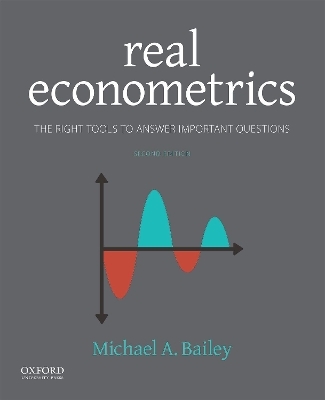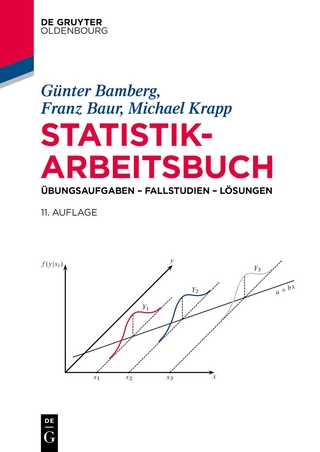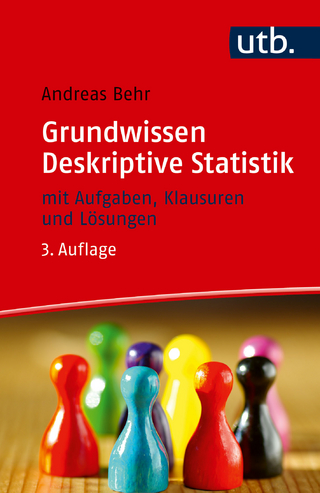
Real Econometrics
Oxford University Press Inc (Verlag)
978-0-19-085746-2 (ISBN)
conversational narrative and a diverse array of examples and case studies, provides students with a solid foundation in the analytical tools they will use throughout their academic and professional careers. The second edition includes new conceptual exercises, revised appendices, and additional code and guidance for R
software.
Michael A. Bailey is the Interim Dean of the McCourt School of Public Policy and the Colonel William J. Walsh Professor of American Government at Georgetown University. He teaches and conducts research on American politics and political economy. His work covering trade, Congress, election law and the Supreme Court, methodology, and inter-state policy competition has been published in the American Political Science Review, the American Journal of Political Science, the Journal of Politics, World Politics, the Journal of Law, Economics, and Organization, among others.
List of Figures
List of Tables
Useful Commands for Stata
Useful Commands for R
Preface for Students: How This Book Can Help You Learn Econometrics
Preface for Instructors: How to Help Your Students Learn Econometrics
Acknowledgments
1 The Quest for Causality
The Core Model
Two Challenges: Randomness and Endogeneity
CASE STUDY: Flu Shots
CASE STUDY: Country Music and Suicides
Randomized Experiments as the Gold Standard
2 Stats in the Wild: Good Data Practices
2.1 Know Our Data
2.2 Replication
CASE STUDY: Violent Crime in the United States
2.3 Statistical Software
I The OLS FRAMEWORK
3 Bivariate OLS: The Foundation of Econometric Analysis
3.1 Bivariate Regression Model
3.2 Random Variation in Coefficient Estimates
3.3 Exogeneity and Unbiasedness
3.4 Precision of Estimates
3.5 Probability Limits and Consistency
3.6 Solvable Problems: Heteroscedasticity and Correlated Errors
3.7 Goodness of Fit
CASE STUDY: Height and Wages
3.8 Outliers
4 Hypothesis Testing and Interval Estimation: Answering Research Questions
4.1 Hypothesis Testing
4.2 t Tests
4.3 p Values
4.4 Power
4.5 Straight Talk about Hypothesis Testing
4.6 Confidence Intervals
5 Multivariate OLS: Where the Action Is
5.1 Using Multivariate OLS to Fight Endogeneity
5.2 Omitted Variable Bias
CASE STUDY: Does Education Support Economic Growth?
5.3 Measurement Error
5.4 Precision and Goodness of Fit
CASE STUDY: Institutions and Human Rights
5.5 Model Specification
6 Dummy Variables: Smarter Than You Think
6.1 Using Bivariate OLS to Assess Difference of Means
CASE STUDY: Sex Differences in Heights
6.2 Dummy Independent Variables in Multivariate OLS
6.3 Transforming Categorical Variables to Multiple Dummy Variables
CASE STUDY: When Do Countries Tax Wealth?
6.4 Interaction Variables
CASE STUDY: Energy Efficiency
7 Specifying Models
7.1 Quadratic and Polynomial Models
CASE STUDY: Global Warming
7.2 Logged Variables
7.3 Standardized Coefficients
7.4 Hypothesis Testing about Multiple Coefficients
CASE STUDY: Comparing Effects of Height Measures
II THE CONTEMPORARY ECONOMETRIC TOOLKIT
8 Using Fixed Effects to Fight Endogeneity in Panel Data and Difference-in-Difference Models
8.1 The Problem with Pooling
8.2 Fixed Effects Models
8.3 Working with Fixed Effects Models
8.4 Two-Way Fixed Effects Model
CASE STUDY: Trade and Alliances
8.5 Difference-in-Difference
9 Instrumental Variables: Using Exogenous Variation to Fight Endogeneity
9.1 2SLS Example
9.2 Two-Stage Least Squares (2SLS)
CASE STUDY: Emergency Care for Newborns
9.3 Multiple Instruments
9.4 Quasi and Weak Instruments
9.5 Precision of 2SLS
9.6 Simultaneous Equation Models
CASE STUDY: Supply and Demand Curves for the Chicken Market
10 Experiments: Dealing with Real-World Challenges
10.1 Randomization and Balance
CASE STUDY: Development Aid and Balancing
10.2 Compliance and Intention-to-Treat Models
10.3 Using 2SLS to Deal with Non-compliance
CASE STUDY: Minneapolis Domestic Violence Experiment
10.4 Attrition
CASE STUDY: Health Insurance and Attrition
10.5 Natural Experiments
CASE STUDY: Crime and Terror Alerts 354
11 Regression Discontinuity: Looking for Jumps in Data
11.1 Basic RD Model
11.2 More Flexible RD Models
11.3 Windows and Bins
CASE STUDY: Universal Prekindergarten
11.4 Limitations and Diagnostics
CASE STUDY: Alcohol and Grades
III LIMITED DEPENDENT VARIABLES
12 Dummy Dependent Variables
12.1 Linear Probability Model
12.2 Using Latent Variables to Explain Observed Variables
12.3 Probit and Logit Models
12.4 Estimation
12.5 Interpreting Probit and Logit Coefficients
CASE STUDY: Econometrics in the Grocery Store
12.6 Hypothesis Testing about Multiple Coefficients
CASE STUDY: Civil Wars
IV ADVANCED MATERIAL
13 Time Series: Dealing with Stickiness over Time
13.1 Modeling Autocorrelation
13.2 Detecting Autocorrelation
13.3 Fixing Autocorrelation
CASE STUDY: Using an AR(1) Model to Study Global Temperature Changes
13.4 Dynamic Models
13.5 Stationarity
CASE STUDY: Dynamic Model of Global Temperature
14 Advanced OLS
14.1 How to Derive the OLS Estimator and Prove Unbiasedness
14.2 How to Derive the Equation for the Variance of O?1
14.3 How to Derive the Omitted Variable Bias Conditions
14.4 Anticipating the Sign of Omitted Variable Bias
14.5 Omitted Variable Bias with Multiple Variables
14.6 Omitted Variable Bias due to Measurement Error
15 Advanced Panel Data
15.1 Panel Data Models with Serially Correlated Errors
15.2 Temporal Dependence with a Lagged Dependent Variable
15.3 Random Effects Models
16 Conclusion: How to Be an Econometric Realist
APPENDICES
Math and Probability Background
A. Summation
B. Expectation
C. Variance
D. Covariance
E. Correlation
F. Probability Density Functions
G. Normal Distributions
H. Other Useful Distributions
I. Sampling
Citations and Additional Notes
Guide to Review Questions
Bibliography
Photo Credits
Glossary
Index
| Erscheinungsdatum | 12.01.2019 |
|---|---|
| Verlagsort | New York |
| Sprache | englisch |
| Maße | 191 x 234 mm |
| Gewicht | 998 g |
| Themenwelt | Wirtschaft ► Volkswirtschaftslehre ► Ökonometrie |
| ISBN-10 | 0-19-085746-3 / 0190857463 |
| ISBN-13 | 978-0-19-085746-2 / 9780190857462 |
| Zustand | Neuware |
| Haben Sie eine Frage zum Produkt? |
aus dem Bereich


